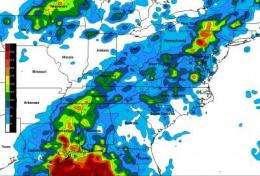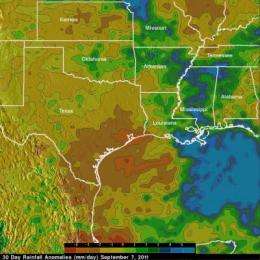NASA satellite rainmap shows extent of Tropical Storm Lee's heavy rainfall

NASA has a rain gauge flying in space called TRMM, and data from that satellite has been used to create a map of the massive rainfall generated by landfalling Tropical Storm Lee.
After forming in the north central Gulf of Mexico, Tropical Storm Lee came ashore over south central Louisiana on the morning of Sunday September 4th, 2011. Over the next two and a half days, the slow-moving storm worked its way across central Louisiana and central Mississippi and into northern Alabama, dumping heavy rains along the way. Tropical Storm Lee joined a frontal system to soak the eastern U.S.
The primary mission of the Tropical Rainfall Measuring Mission or TRMM satellite is to measure rainfall over the global Tropics using a combination of passive microwave and active radar sensors. TRMM is a joint mission between NASA and the Japanese space agency JAXA. For expanded coverage, TRMM can be used to calibrate rainfall estimates from other satellites. Rainfall estimates from the TRMM-based, near-real time Multi-satellite Precipitation Analysis (TMPA) at the NASA Goddard Space Flight Center in Greenbelt, Md. are shown here for the period August 31 to September 8, 2011 for the eastern half of the U.S.
TMPA shows heavy rains extending inland from the northern Gulf of Mexico across eastern Louisiana, Mississippi, northwestern Alabama, and into central Tennessee. Rainfall totals in this region generally exceed 100 mm (~4 inches) with some parts of Mississippi and Louisiana receiving upwards of 250 mm (~10 inches) Chattanooga, Tennessee broke their all time 24-hour rainfall total with 9.69 inches.
After coming ashore, Tropical Storm Lee began to merge with a slowing-moving frontal system advancing eastward out of the Mississippi valley. This frontal system was associated with a quasi-stationary upper-level low pressure center located over the Ohio valley. As a result, tropical moisture was drawn up the eastern seaboard, bringing heavy rains from the mid-Atlantic up into the northern Appalachians.
TMPA rainfall totals of 125 mm (~5 inches, shown in bright green) to as much as 200 to 250 mm (~8 to 10 inches, shown in orange and red) extend from south central Pennsylvania up into central New York, where the Susquehanna River reached record flood levels in downtown Binghamton. Elsewhere across the mid-Atlantic, where pockets of rain exceed anywhere from 100 to 150 mm (~4 to 6 inches), numerous roads and streets were closed due to widespread localized flooding.
On Sept. 9, 2011 at 5 a.m. EDT, heavy rains associated with Lee's remnants are slowly coming to an end across the Mid-Atlantic. The large-scale extra-tropical low pressure area that absorbed Lee's moisture and energy was centered over Indiana and will continue weakening. Meanwhile, The National Weather Service's Hydrometeorological Prediction Center (HPC) expects "tropical moisture to continue streaming up from the Atlantic Ocean leading to the potential for another round of heavy rains across the region."

For updated rain totals from Tropical Storm Lee, visit the HPC's webpage: www.nhc.noaa.gov/text/refresh/ … 3+shtml/090857.shtml .
While much of the nation east of the Mississippi received too much rain, there was no relief for Texas and parts of the Central Plains, which remain locked in a drought. TRMM satellite data is also helpful in determining areas of drought.
At NASA Goddard, TMPA rainfall anomalies were created for the one-month period from August 7 to September 7, 2011 that showed a stark contrast between the drought-stricken, well-below normal areas (nearly all of Texas and most of Kansas) and those with well-above normal rain along and east of the Mississippi due to the passage of Lee. The anomalies were constructed by computing the average rainfall rate over the period and then subtracting the 10-year average rate for the same period.
Those drought-stricken areas are hoping that Tropical Storm Nate, currently in the southwestern Gulf of Mexico will bring them some wet relief.
Provided by NASA's Goddard Space Flight Center




















